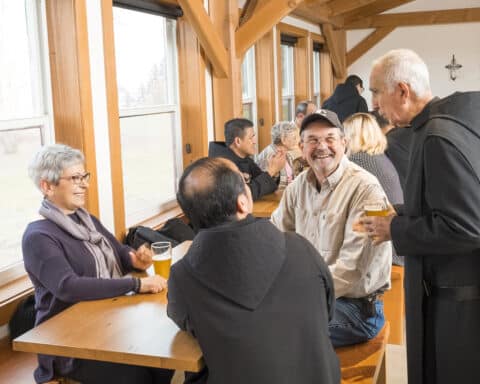“I’m not religious, but I am spiritual.”
How often have you heard someone say something similar? Or perhaps even said it yourself. In our secular culture, being “religious” is often seen as being narrow-minded, judgmental and a bit of a nutcase. It may also mean being overly concerned with rules, regulations and laws. At the very least, a religious person belongs to an organized religion and consistently attends services.
In contrast, being “spiritual” has come to mean someone who has a relationship with God, even if “god” is simply defined as a higher power or the forces of nature. Generally, a “spiritual” person doesn’t go to church or adhere to organized faith practices, but lives according to an individualized moral code.
This sort of clear-cut distinction between being religious and being spiritual is a relatively modern construct. Such a dichotomy would have been completely mystifying to most of our ancestors. In the Catholic sense, religion may be thought of as the structured belief system of our faith — its theology, organized practices and doctrines on an almost corporate level. Spirituality is the way those beliefs are lived personally, daily and privately.
In his book “The Search for Spirituality: Seven Paths within the Catholic Tradition” (Liffey Press, $26.95), Stephen Costello explains: “Spirituality covers the domain of religious experience of the divine. It is primarily experiential and practical/existential, rather than abstract/academic and conceptual.” In some ways, religion is like Vatican City and St. Peter’s and spirituality is like your hometown and home parish. The same sort of things happen in both places, but one is public and the other is more private; one is for everyone, the other is for you and your family; one is almost too big to comprehend, the other is part and parcel of daily life.
Many members, one Body
The Catholic Church has recognized, almost from the beginning, that living the faith is not a “one size fits all” proposition. The Church in Jerusalem had a different character and flavor from the Church in Rome or the Church in Ephesus or the Church in Thessalonica. As the faith matured, even more varied spiritual approaches began to emerge under the inspiration of saints such as Dominic and Francis, extending even to modern times with Josemaria Escriva and others.
Obviously, if someone is contemplating a vocation as a priest, sister or brother, the different spiritual paths are an important part of the discernment process. A person with a passion for serving the poor would not fit well in a Trappist monastery nor would a contemplative who longs for a life of study in a Benedictine Abbey be happy working as a Dominican on a college campus.
However, the spiritual traditions are important to lay Catholics as well, sometimes formally as a member of a secular order, but also informally as the charisms, styles of prayer and inspiration of the founders of the spiritual ways influence daily life.
“If God’s creation is anything, it is diverse, and God intentionally desires every diversity,” says Dominican Father Fred Lucci, director of the All Saints Catholic Newman Center at Arizona State University in Tempe, Ariz. “That diversity is most evident in the uniqueness of every human person and various temperaments. While union with God, the end of spirituality, is a desire of every human heart, different persons with different temperaments will naturally find different paths through different prayer forms to that union. Throughout history, God has inspired the creation of various religious orders and congregations, each with its own charism to address a particular need in the Church. In responding to their charisms, each developed a spirituality that reflects and supports their charism.
“Any layperson desiring a deeper relationship with God would be wise to pursue the various spiritualities of the orders and congregations for one that might be helpful to her own temperament,” he adds.
For example, a mother with a longing to experience the quiet and solitude of life within a cloister might find making an annual retreat at an abbey helps make her a better wife and parent. A businessman who is moved by images of starving children may decide to make a regular contribution to the Sisters of Charity for their mission work. Or, more simply, a person who finds great joy in uplifting poetry may become immersed in the works of the Carmelite John of the Cross, while a more active person may want to try out St. Dominic’s Nine Ways of Prayer.
To choose a spiritual way within the Church is to enhance the religious experience, not oppose it. It is a way to grow and mature in faith while still being an active participant in the corporate life of the Church.
How to choose
A person doesn’t so much choose a spiritual path, but rather as he or she discovers the path that fits the best with personality, temperament and overall outlook on life. Sometimes, by virtue of attending a parish run by Jesuits or Dominicans or Franciscans, a person will become more closely united with that way. Other times, reading the lives of the saints, examining the way of life of the professed members of an order and good old-fashioned prayer, asking for discernment and guidance, will still be the best way to find a discipline and practice that helps build a person’s faith and spiritual life.
Benedictines: The Rule
Hence, brethren, if we wish to reach the greatest height of humility, and speedily to arrive at that heavenly exaltation to which ascent is made in the present life by humility, then, mounting by our actions, we must erect the ladder that appeared to Jacob in his dream, by means of which angels were shown to him ascending and descending (see Gn 28:12). Without a doubt, we understand this ascending and descending to be nothing else but that we descend by pride and ascend by humility.”
— Rule of St. Benedict, Chapter VII
Do you enjoy Scripture reading, formal prayers of the Church and have the gift of hospitality? Benedictine spirituality may be for you.
Founded by St. Benedict of Nursia in the sixth century, the Benedictines are the oldest of the spiritual communities. His “rule,” or book of guidance, has been adapted and adopted by many other communities over the centuries.
“The Benedictine answer to spirituality is the Scriptures, the scriptural way,” says Benedictine Father Jeremy Driscoll, monk at Mount Angel Abbey in Oregon and professor of patristics at Mount Angel Seminary.
“Benedict tries to be nothing more and nothing less than Scripture at full throttle,” he explains. “To quote the holy rule: Let nothing be preferred to the work of God, which refers to the Divine Office. The center of Benedictine life is the gathering in the Church for the various hours of the praise of God in common.”
The ingredients of Benedictine spirituality are to “center life on praise of God, life together (we don’t go to God alone) É many hours devoted to prayerful reading of Scriptures alone, and hospitality — to call that spirituality is significant,” he adds. “Benedict said the Lord is received and adored in the guests.”
Dominicans: To Preach the Word
A man who governs his passions is master of his world. We must either command them or be enslaved by them. It is better to be a hammer than an anvil.”
–St. Dominic
Do you love to study and have a passion for explaining the faith through writing and speaking? Then consider the Dominican way.
While Dominican scholars like St. Thomas Aquinas have shaped Catholic theology for centuries (the theologian of the papal household has traditionally been a Dominican), the goal of Dominican study is to understand the truth in order to preach the Good News. In fact, St. Dominic, the founder, explicitly said that the order was created for “preaching and the salvation of souls.”
“Dominican spirituality derives from the reality that anything that is true points to God the Creator, and therefore all learning, knowledge and understanding ultimately teaches us about God. The more we know of God, the more we can love God,” says Dominican Father Fred Lucci, director of the All Saints Newman Center at Arizona State University in Tempe, Ariz. “Therefore, Dominican spirituality begins with study, always with the question in mind: ‘What more does this teach me about who I am and who God is in my life?’ Additionally, as the Order of Preachers, we are aware that love is the ultimate truth and true love cannot be contained. And so while all insights draw us into a deeper understanding and love of God, they are always given to be shared so others can also better know and love God.”
“It is in the act of sharing that we experience the joy of exercising our baptismal call to share in prophetic mission of Jesus,” he adds. “Comtemplata alis tradere — that is, giving to others, the fruits of our contemplation. Dominican spirituality, then, is ultimately a path to God through the search for knowledge, contemplation of that knowledge for deeper understanding of the Divine and the joy of preaching that truth to the world.”
Franciscans — The Way of Simplicity
We adore you Most Holy Lord Jesus Christ, here and in all of your churches throughout the world and we bless you, because by your Holy Cross you have redeemed the world.”
— St. Francis of Assisi
Does the simple life attract you? Do you want to see all of life as gift and all creatures as united in Christ? Then look to St. Francis and the Franciscan Way.
Franciscan spirituality is “very simple and very personal and very devotional,” explains Father Benedict Groeschel, C.F.R., “Devotional [means] it is related to personal individual prayer to Christ and Our Lady and their presence in our life.”
“Like its founder, the beloved Francis of Assisi, Franciscan spirituality stresses personal devotion to Christ, particularly to Christ in his incarnation, his passion and death and his presence in the Holy Eucharist,” Father Groeschel goes on to say. Franciscans look to the “Christ child, Christ crucified, Christ in the Eucharist.”
Perhaps the best-known quality of this “school of spirituality,” as Father Groeschel calls it, is an “emphasis on simplicity, humility and care of the poor; it’s not a complex spirituality.” It is, however, one of the most popular paths, appealing even to non-Catholics and non-Christians because of its affection for all creation and love of life.
Jesuits: The Ignatian Exercises
Receive, Lord, all my liberty, my memory, my understanding and my whole will. You have given me all that I have, all that I am, and I surrender all to your divine will, that you dispose of me. Give me only your love and your grace. With this I am rich enough, and I have no more to ask.”
— St. Ignatius Loyola
Do you long to know the will of God in all things? Is a straightforward, no-nonsense approach that finds God in the everyday things of life appealing? You may find Ignatian spirituality appealing.
The founder of the Society of Jesus, also called Jesuits, St. Ignatius Loyola, was a soldier who came to the point of conversion after having his leg broken. During his recuperation, he had only the Lives of the Saints and the Life of Christ to read. (He wanted the romances.) Ironically, his great legacy, the “Spiritual Exercises,” is one of the most widely read books in the Western world. Practical and to the point, the exercises are a monthlong program of meditations, prayers and contemplative practices.
“Ignatian spirituality is focused on finding God in all things,” says Jesuit Father James Martin, author of “My Life with the Saints” (Loyola, $15.95). “It is centered on the idea that the experiences of God are not reserved for one Sunday during Sunday Mass, but God can be found at every moment of our life and every moment we can experience God. All things that are part
of our lives help us experience God,” he adds. The Jesuit Way is “contemplative in action,” he explains. “It’s for the person who lives an active life, but maintains a contemplative life. If you are a young mother, Ignatian spirituality says that God can be found in your relationship with your children, your husband, your friends, preparing the sandwiches in the morning, in the office, in the struggles raising children, in the love you experience in raising your children in addition to the formal times you go to Church. It pays a great deal of attention to feelings, desires and emotions as ways God calls us. Ignatian spirituality is intent on reminding people that the temptation exists to box God into one hour on Sunday. The great gift of Ignatian spirituality is finding God in all things.”
Opus Dei — The Work of God
“In order to love and serve God, it is not necessary to do extraordinary things. Christ asks all men without exception to be perfect as his heavenly Father is perfect (see Mt 5:48). For the great majority of men, to be holy consists of sanctifying their work, to sanctify themselves in their work, to sanctify others with work, and also to find God on the road of their life.”
— St. Josemaria Escriva
Are you convinced that holiness is found in boardrooms and lunchrooms as well as chapels and churches? Consider the way of Opus Dei.
One of the newest spiritual paths in the Church is Opus Dei, which was founded in Spain in 1928 by the Catholic priest St. Josemaria Escriva. The guiding principle behind the movement is that holiness is attainable by everyone, and ordinary life is the way to sanctity. The majority of its members are laypeople.
“We are all called to holiness,” says John Cloverdale, law professor at Seton Hall University and author of “Uncommon Faith, The Early Years of Opus Dei (1928-1943)” a history of St. Josemaria Escriva and the foundational years of Opus Dei. “The supposition is that priests need a spirituality (but we have the) idea that laypeople are just called to muddle through. We are all called to holiness through different paths.” Coverdale explains that three points characterize Opus Dei:
“First, a stress on integrating the secular into one’s spiritual life, rather than seeing everyday life as a problem to be overcome, it is part and parcel of where we are to sanctify ourselves.
“Second, an emphasis on work, understood broadly, as the whole range of activities, seen as a path to sanctity. [God] wants us to do it well and offer it to him. The first step is to do it and do it well.
“Third, a very strong stress on the reality of being sons and daughters of God that gives an optimistic and positive tone to love. God really does love us and is concerned about each of us.”
Sampling of orders
A complete list of religious orders within the Catholic Church would take up pages upon pages, but here are a few more of the many roads of spirituality in the Catholic faith.
Carmelites, a contemplative order characterized by such great saints as Teresa of Avila, John of the Cross and Therese of Lisieux, trace their beginning to hermits who settled on Mount Carmel in the Holy Land.
The Missionaries of Charity, founded by Blessed Teresa of Calcutta in 1950, take a fourth vow in addition to the traditional vows of obedience, chastity and holiness — to serve the poorest of the poor. The Missionaries of Charity family is made up of active sisters and contemplative sisters, active and contemplative brothers, Religious priests, diocesan priests and laypeople.
Cistercians or Trappists, made famous by Thomas Merton and his book “The Seven Storey Mountain,” are a monastic order dating back to 1098, founded by a group of Benedictine monks who were dissatisfied with the relaxed observance of their abbey. Severe asceticism and manual labor are an important part of the order’s life.
Augustinians, based on the writing and teaching of St. Augustine of Hippo, focus their apostolic activity on education, parochial ministry and missionary work.
Maryknollers, whose official name is Catholic Foreign Mission Society of America, train missionaries for work throughout the world.
Salesians, founded by St. John Bosco in 1859 and named after St. Francis De Sales, work on behalf of young people throughout the world.
Redemptorists, otherwise known as the Congregation of the Most Holy Redeemer, were founded by St. Alphonsus Liguori in 1732. Redemporists live in missionary communities throughout five continents.
Servites, also called the Order of Friar Servants of Mary, received approval from the Vatican in the early 14th century. It is one of the original mendicant orders in the Catholic Church.
Secular or third orders
Sometimes a person feels an affinity to a particular religious order, although not a call to a religious vocation. In those cases, the person may choose to join a secular order. Such orders are defined by the Code of Canon Law as “associations whose members live in the world but share in the spirit of some religious institute, under the overall direction of the same institute, and who lead an apostolic life and strive for Christian perfection, are known as third orders, or are called by some other suitable title” (Canon 303).
Members are sometimes called tertiaries or third order from the Latin word meaning third. The term derives from the order in which a religious community grew with monks and/or priests first, then nuns and sisters and finally laity. The lay vocation is a way of incorporating the distinctive outlook and charism of a religious order into ordinary life, work and families.
Resources
“The Search for Spirituality: Seven Paths within the Catholic Tradition,” by Stephen J. Costello
Nine Ways of Prayer, by St. Dominic
Woodeene Koenig-Bricker writes from Oregon.





